When it comes to boat repair, epoxy and polyester resins are both popular choices. But which one is the best option? Epoxy resin is known for its strong bonding properties, making it ideal for repairing cracks and holes. It also has excellent waterproofing qualities, making it ideal for boats that spend a lot of time in the water. Polyester resin, on the other hand, is a bit more flexible than epoxy, making it better suited for repairs that require some give. It’s also less likely to yellow over time, making it a good choice for boats that will be spending a lot of time in the sun. Ultimately, the best choice of epoxy or polyester resin for boat repair depends on the type of project you are tackling.
General Purpose Repair Epoxy Resin Kit
 Every household should own a Hawk Epoxy Kit like this. You can use it to repair anything around your home or own your boat. This kit comes with the resin, catalyst and your choice of filler. Just mix them together and you have an excellent bonding, filling, or adhesive paste.
Every household should own a Hawk Epoxy Kit like this. You can use it to repair anything around your home or own your boat. This kit comes with the resin, catalyst and your choice of filler. Just mix them together and you have an excellent bonding, filling, or adhesive paste.
FGCI General Purpose Resin is used for laminating with fiberglass, kevlar and carbon reinforments. It can be tinted with pigment up to 3% and best results are when used at 70-85 degrees F. Hardener varies depending on thickness of fiberglass, the more fiberglass the less hardener as you will generate more heat-never go below 1%. Complete cure needs sanding aid added to resin or PVA while still hot.
Polyester Resin:
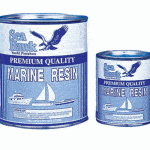 Polyester resins are unsaturated resins that are combined with hardeners, such as MEKP.
Polyester resins are unsaturated resins that are combined with hardeners, such as MEKP.
Polyester resin is used more for fiberglass lay-up or if you’re going to finish a repair with gelcoat, as the polyester resin will bond to the gelcoat better than epoxy. It is also cheaper than epoxy and a great choice when casting deep molds.
Various Types of Polyester Resin:
Boatyard Polyester Resin is a non-specified resin that contains different types of polyester resins and wax. Boatyard Polyester Resin is not recommended for use below the waterline. The material may cure hard and tack-free due to the included wax. If so, the product will need to be sanded prior to adding another layer in order to promote good bonding.
Clear Casting Polyester Resin is used to cast small objects into a mold. This method can be used to create sculptures, crafts, or industrial prototypes.
Surfboard Polyester Resin is Clear & wax free. It is ideal for building & repairing surfboards because it cures to an almost clear color when applied in a film. Also it highlights underlying graphics.
Iso Marine Resin is based on isophthalic acid. This resin is a step above the general purpose polyester resin and that is reflected in the price. Iso Resin is stronger, more durable, and is the best choice when applying in corrosion environments or elevated temperatures.
Vinyl Ester Resin:
Vinyl ester resins are formulated with a base of polyester resin strengthened with epoxy molecules (a hybrid form of polyester and epoxy and aiding for gelcoat to bond with epoxy) and also use peroxides, such as MEKP, for hardening. These are cheaper than epoxy resins and more expensive than polyester. Ideal temp for use is 77 F, not applied over 1/8th thickness or it will generate too much heat.
Vinyl esters are more tolerant of stretching, less likely to show stress cracking and more resistant to water penetration. Vinyl ester is the choice when improved resistance to moisture is the goal (like repairing a blistered hull).
Long term water exposure (hull or water tank) or if impact resistance is important vinyl ester is usually chosen.
Epoxy Resin:
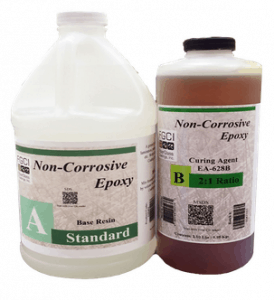 Epoxy resins are cured with the addition of a hardener. Unlike the polyester and vinyl ester resins, cured with a small amount of catalyst, epoxy resins usually require a lot more, often 1:1 or 2:1. A epoxy resin is the most expensive of these.
Epoxy resins are cured with the addition of a hardener. Unlike the polyester and vinyl ester resins, cured with a small amount of catalyst, epoxy resins usually require a lot more, often 1:1 or 2:1. A epoxy resin is the most expensive of these.
Epoxy resin has the best bonding strength as it will bond dissimilar or already cured materials for strong, reliable repair work. This is the most expensive resin but offers the most in its ability to flex, prevent delamination and ease of repair work.
If doing a repair and not overlaying with gelcoat then the epoxy will perform best as it tends to act as a stronger “glue” for the patch to the surrounding surface.
Laminating Epoxy Resin is the correct choice for repairing boats. It is super durable and has high resistance to water. Also, it has very good adhesion to a variety of surfaces including metals, plastics, fiberglass, wood, and glass. The ratio is well suited for use with high-solids marine, maintenance coating and bonding agents. The cure time is three days in the sun or a week if it is not. Set time changes with activator and film thickness. If there is an excessive amount of activator applied , the laminating epoxy will be soft and rubbery. In contrast, if there is not enough activator, the epoxy will not cure hard. Laminating Epoxy is available in 3 different ratios that provide different working and cure times.
Epoxy Resin (Bar Top Epoxy Resin):
A Premium Commercial Grade Clear Epoxy Resin – Klear Kote Epoxy Resin is used extensively in coating surfaces and in table tops where a clear, hard and durable coating is required. Commonly seen on bar tops and restaurant tables. Easy to use 1:1 mixing ratio of resin and hardener. Items coated with it will become permanently preserved and protected for your enjoyment throughout a lifetime. The epoxy resin will not exhibit blushing or sweat out under high humidity conditions.
Epoxy Resin Kits
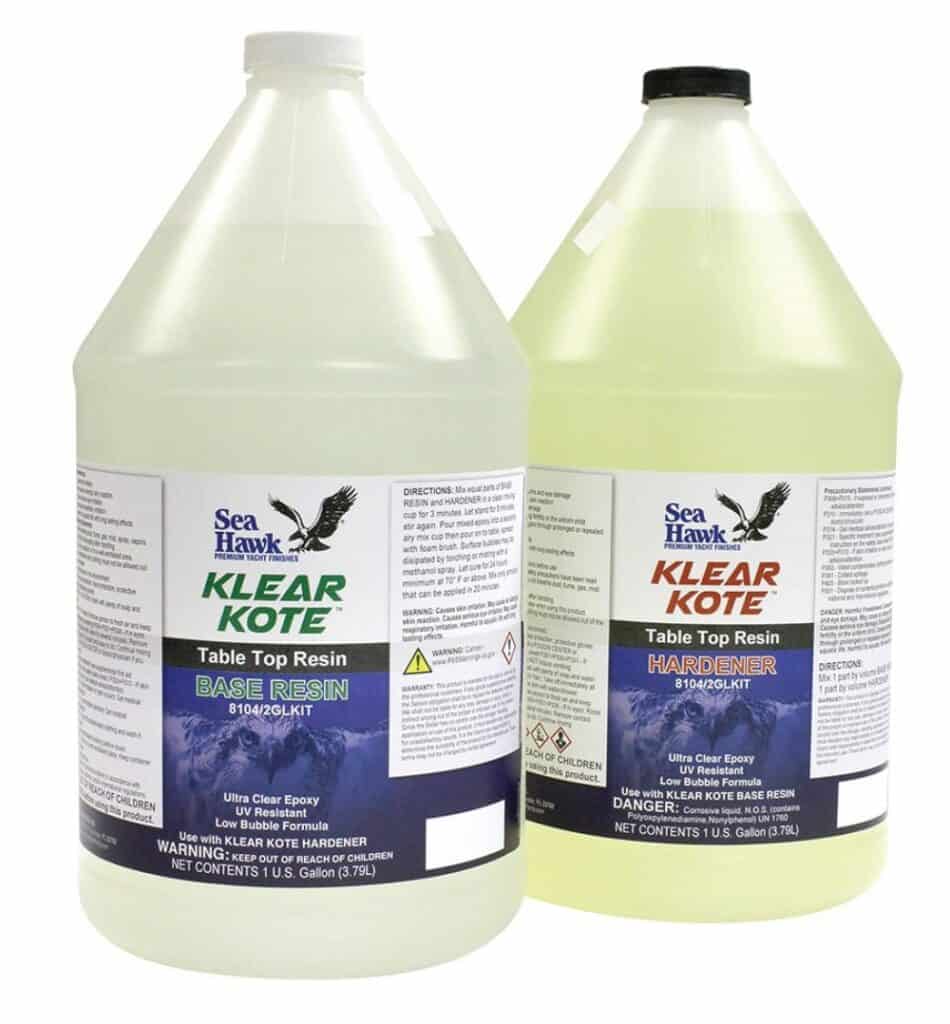
Epoxy resin kits are sold in two parts, A and B, which should be applied in two stages. The first stage is referred to as the seal coat. The seal coat is brushed on in a thin layer and is used to seal any pores on the surface and prevent air bubbles from forming in the following flood coats. This stage is followed by the flood coat, which will flow and self-level, clean brushes or squeegees can be used to help spread the epoxy. Flood coats are applied in 1/8″ layers at a time, as many as desired can be applied, however, one to three coats is average for most table or bar coatings. Resin kits are often applied on bar tops and tabletops in many bars and restaurants.
Superbond Standard Epoxy Glue
Superbond Standard Epoxy Glue is a two-part, 1:1 epoxy adhesive that has a Vaseline consistency. The product adheres to nearly everything and is a favorite among woodworkers. It’s offered in a fast curing agent, giving 8-15 minutes of working time; a medium, giving 20-30 minutes, and a standard, offering 30-45 minutes. SuperBond is offered in sizes from ½-pint tubs all the way to 5-gallon pails.
Rot Stop Epoxy
Rot stop epoxy is a 2-part epoxy that is 1:1 ratio and is very simple to mix. The coverage is similar to other epoxies, and like other epoxies, the product does vary in thickness based on temperature. The advantage of Rot Stop is it is NOT affected by moisture, making it excellent for deck or flooring and cracking repair, especially moisture damage.
See catalyst chart for mixing guidance:
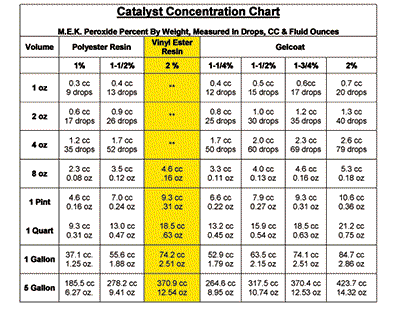
NOTE: Using drops for catalyst is only an estimate. In Critical applications MEKP should be measure by using CC’s or Fluid Ounces which are volume measurements. The percentages in the chart: 1% thru 2% are percentages of gelcoat by weight.The CC’s and OZ’s values in the chart have been converted from weight of MEKP to volumes of MEKP.
Resin guns
Gelcoat and resin spray guns are ideal for large surface spraying, such as new mold construction, composite refinishing and large boat surfaces. Look for a resin gun with a blue die cast body which will ensure a long life. Most HVLP cup guns use nylon flat seal just behind the threads that the air cap attaches to.
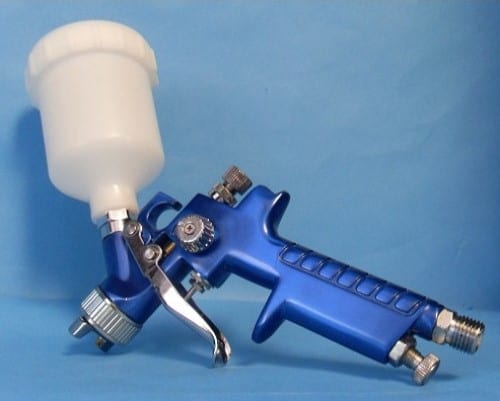
If you have used a spray gun with a nylon flat seal just behind the threads that the air cap attaches to and cleaned it with acetone, the seals disintegrate so it is best to use one with a plastic seal.
